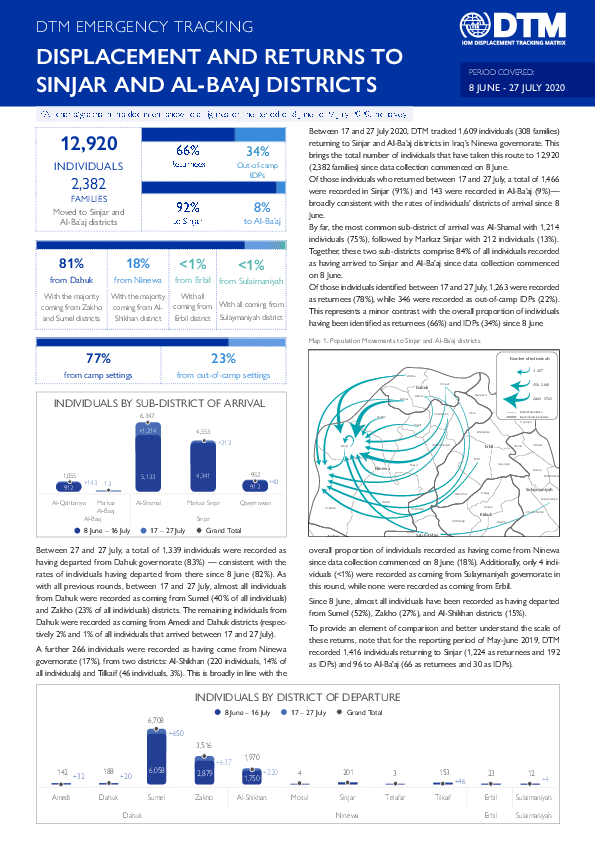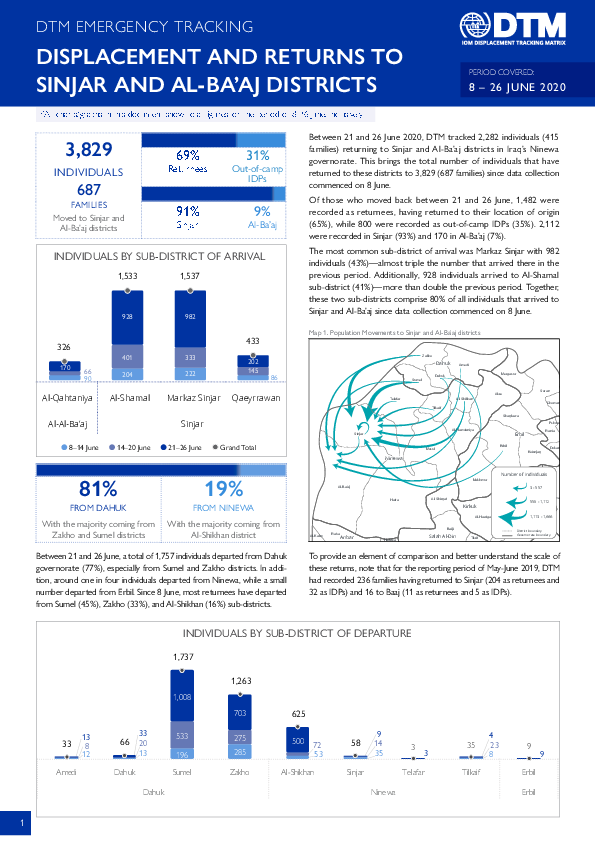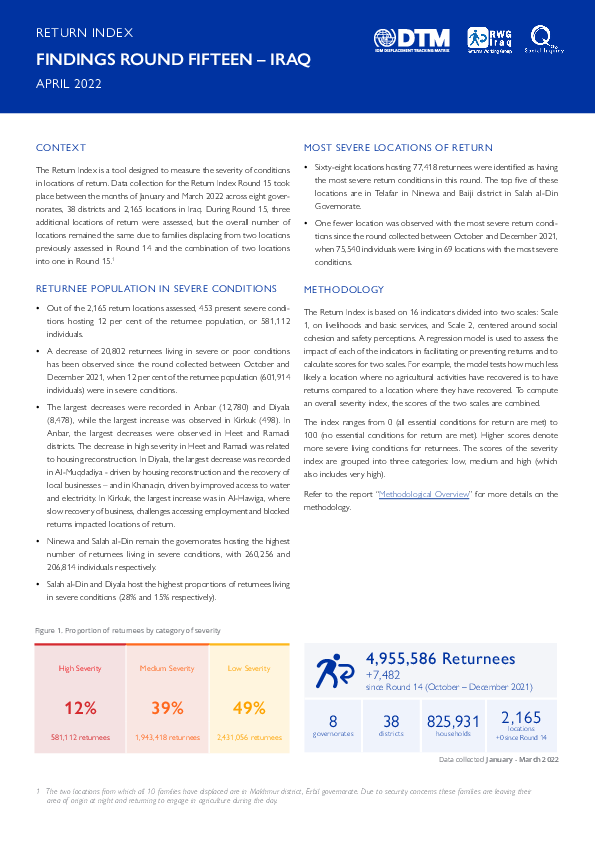-
Countries
-
Data and Analysis
-
Special Focus
-
Crisis Responses
Return migration

Contact
DTM Iraq, IraqDTM@iom.int
Language
English
Location
Iraq
Period Covered
Jun 08 2020
Aug 06 2020
Activity
- Mobility Tracking
Between 28 July and 6 August 2020, DTM tracked 839 individuals (160 families) returning to Sinjar and Al-Ba’aj districts in Iraq’s Ninewa Governorate. This brings the total number of individuals that have taken this route to 14,704 (2,711 families) since data collection commenced on 8 June.
Of those individuals who returned between 28 July and 6 August, a total of 690 were recorded in Sinjar (82%) and 149 were recorded in Al-Ba’aj (18%). This is broadly consistent with the rates of individuals’ districts of arrival since 8 June.
During the period between 28 July and 6 August, the average number of daily individual arrivals was 69 to Sinjar and 17 to Al-Ba’aj. This is significantly lower than the overall daily average number of individual arrivals since 8 June to Sinjar (222 individuals) and Al-Ba’aj (23) The most common sub-district of arrival was Markaz Sinjar with 349 individuals (42%), followed by Al-Shamal with 229 individuals (27%). Together, these two sub-districts comprise 82% of all individuals recorded as having arrived to Sinjar and Al-Ba’aj since data collection commenced on 8 June.
Of those individuals identified between 28 July and 6 August, 584 were recorded as returnees (70%), while the remaining 255 were recorded as out-of-camp IDPs (30%). This this is consistent with the overall proportion of individuals having been identified as returnees (66%) and out-of-camp IDPs (34%) since 8 June.

Contact
DTM Iraq, IraqDTM@iom.int
Language
English
Location
Iraq
Period Covered
Jun 08 2020
Jul 27 2020
Activity
- Mobility Tracking
Between 17 and 27 July 2020, DTM tracked 1,609 individuals (308 families) returning to Sinjar and Al-Ba’aj districts in Iraq’s Ninewa governorate. This brings the total number of individuals that have taken this route to 12,920 (2,382 families) since data collection commenced on 8 June.
Of those individuals who returned between 17 and 27 July, a total of 1,466 were recorded in Sinjar (91%) and 143 were recorded in Al-Ba’aj (9%)— broadly consistent with the rates of individuals’ districts of arrival since 8 June.
By far, the most common sub-district of arrival was Al-Shamal with 1,214 individuals (75%), followed by Markaz Sinjar with 212 individuals (13%). Together, these two sub-districts comprise 84% of all individuals recorded as having arrived to Sinjar and Al-Ba’aj since data collection commenced on 8 June.
Of those individuals identified between 17 and 27 July, 1,263 were recorded as returnees (78%), while 346 were recorded as out-of-camp IDPs (22%). This represents a minor contrast with the overall proportion of individuals having been identified as returnees (66%) and IDPs (34%) since 8 June.

Contact
DTM Iraq, IraqDTM@iom.int
Language
English
Location
Iraq
Period Covered
Jun 08 2020
Jul 10 2020
Activity
- Mobility Tracking
Between 4 June and 10 July 2020, DTM tracked 2,169 individuals (542 families) returning to Sinjar and Al-Ba’aj districts in Iraq’s Ninewa governorate. This brings the total number of individuals that have returned to these districts to 8,581 (1,567 families) since data collection commenced on 8 June.
Of those individuals who moved back between 4 and 10 July, a total of 1,963 were recorded in Sinjar (91%) and 206 were recorded in Al-Ba’aj (9%)—broadly consistent with the rates of individuals’ districts of arrival since 8 June.
The most common sub-district of arrival was Al-Shamal with 1,221 individuals (56%), followed by Markaz Sinjar with 599 individuals (28%). Together, these two sub-districts comprise 84% of all individuals recorded as having arrived to Sinjar and Al-Ba’aj since data collection commenced on 8 June.
Of those individuals identified between 4 and 10 July, 1,462 were recorded as returnees (67%), while 707 were recorded as out-of-camp IDPs (33%).
Between 4 and 10 July, a total of 1,948 individuals were recorded as having departed from Dahuk governorate (90%)—representing a 9% increase to the proportion of individuals that came from there in the previous period (27 June – 3 July). As with all previous rounds, between 4 and 10 July, almost all individuals from Dahuk were recorded as coming from from Sumel (74%) and Zakho (23%) districts.
Further, only 221 individuals were recorded as having come from Ninewa governorate (10%)—mainly from Al-Shikhan (134 individuals) and Sinjar (51 individuals). This is significantly lower than the overall proportion of individuals recorded as having come from Ninewa since data collection commenced on 8 June (25%). No individuals were recorded as having come from Erbil in this round.
Since 8 June, the majority of individuals have departed from Sumel (53%) and Zakho (27%).
To provide an element of comparison and better understand the scale of these returns, note that for the reporting period of May-June 2019, DTM recorded 1,416 individuals returning to Sinjar (1,224 as returnees and 192 as IDPs) and 96 to Al-Ba’aj (66 as returnees and 30 as IDPs).

Contact
DTM Iraq, IraqDTM@iom.int
Language
English
Location
Iraq
Period Covered
Jun 08 2020
Jun 26 2020
Activity
- Mobility Tracking
- Baseline Assessment
Between 21 and 26 June 2020, DTM tracked 2,282 individuals (415 families) returning to Sinjar and Al-Ba’aj districts in Iraq’s Ninewa governorate. This brings the total number of individuals that have returned to these districts to 3,829 (687 families) since data collection commenced on 8 June.
Of those who moved back between 21 and 26 June, 1,482 were recorded as returnees, having returned to their location of origin (65%), while 800 were recorded as out-of-camp IDPs (35%). 2,112 were recorded in Sinjar (93%) and 170 in Al-Ba’aj (7%).
The most common sub-district of arrival was Markaz Sinjar with 982 individuals (43%)—almost triple the number that arrived there in the previous period. Additionally, 928 individuals arrived to Al-Shamal sub-district (41%)—more than double the previous period. Together, these two sub-districts comprise 80% of all individuals that arrived to Sinjar and Al-Ba’aj since data collection commenced on 8 June.
Between 21 and 26 June, a total of 1,757 individuals departed from Dahuk governorate (77%), especially from Sumel and Zakho districts. In addition, around one in four individuals departed from Ninewa, while a small number departed from Erbil. Since 8 June, most returnees have departed from Sumel (45%), Zakho (33%), and Al-Shikhan (16%) sub-districts.
To provide an element of comparison and better understand the scale of these returns, note that for the reporting period of May-June 2019, DTM had recorded 236 families having returned to Sinjar (204 as returnees and 32 as IDPs) and 16 to Baaj (11 as returnees and 5 as IDPs)

Contact
iomisbdtmremapteam@iom.int
Language
English
Location
Pakistan
Period Covered
Apr 23 2022
May 06 2022
Activity
- Flow Monitoring
IOM Pakistan collects data on the outflows of undocumented Afghan migrants at the Torkham and Chaman border crossing points in an effort to better understand the migration movements of undocumented Afghan migrants returning to Afghanistan from Pakistan. This exercise is part of the European Union funded project “Displacement Tracking Matrix Regional Evidence for Migration Analysis and Policy (DTM REMAP)”.
From 23 April to 06 May 2022, 805 undocumented Afghan migrants returned to Afghanistan, including 265 through the Torkham border point and 540 through the Chaman border point. During the reporting period, border authorities facilitated the return of 59 individuals due to the lack of legal documentation to remain in Pakistan. Therefore, information concerning these 59 individuals is not included in the report analysis.

Contact
DTM Iraq, IraqDTM@iom.int
Language
English
Location
Iraq
Period Covered
Jan 01 2022
Mar 31 2022
Activity
- Survey
- Return Intention
- Mobility Tracking
- Baseline Assessment
The Return Index is a tool designed to measure the severity of conditions in locations of return. Data collection for the Return Index Round 15 took place between the months of January and March 2022 across eight governorates, 38 districts and 2,165 locations in Iraq. During Round 15, three additional locations of return were assessed, but the overall number of locations remained the same due to families displacing from two locations previously assessed in Round 14 and the combination of two locations into one in Round 15.
This document presents an analysis of interviews conducted with all individuals assisted in their voluntary return by the International Organization for Migration (IOM) between 2017 and 2021 (130,424) to one of the 23 countries covered by the West and Central Africa region (WCA). The analysis combines datasets from both Assisted Voluntary Return and Reintegration (AVRR) and Voluntary Humanitarian returns (VHR).

Contact
DTM Europe, DTMMediterranean@iom.int
Language
English
Location
Republic of Moldova
Period Covered
Apr 16 2022
Apr 22 2022
Activity
- Survey
- Return Intention
Since 24 February 2022, an increasing number of people fleeing from Ukraine to the neighbouring countries has been observed, as a result of the war in Ukraine. At the same time, the number of persons exiting the Republic of Moldova and going back to Ukraine has been sustained.
Since 16 April, IOM’s DTM has deployed displacement surveys with Ukrainians and third country nationals (TCNs) before crossing to Ukraine at two main border crossing points (BCPs) – Palanca and Otaci – in the Republic of Moldova. Individual crossings back into Ukraine are not necessarily returnees and conclusions on definitive trends cannot yet be drawn. The sample is not representative of all persons crossing to Ukraine, and results should only be considered as indicative.

Contact
DTM South Sudan, SouthSudanDTM@iom.int
Language
English
Location
South Sudan
Period Covered
Sep 20 2021
Oct 30 2021
Activity
- Survey
- Return Intention
Between September and November 2021, the International Organization for Migration’s Displacement Tracking Matrix (IOM DTM) undertook its second household-level multi-sector assessment of selected urban areas and camps for internally displaced persons (IDPs) in South Sudan. The assessment aims to:
- Quantify the prevalence of vulnerabilities and humanitarian needs across sectors, with a focus on food security, economic vulnerability and nutrition as well as selected indicators on shelter and non-food items (SNFI), education, health, water, hygiene and sanitation (WASH), protection (including child protection and gender-based violence) and mental health and psycho-social support (MHPSS).
- Generate a better understanding of urban displacement and migration, including return and relocation after displacement in South Sudan or abroad.
This survey is part of the country-wide extended Food Security and Nutrition Monitoring System (FSNMS+) assessment in South Sudan, jointly conducted by IOM, the World Food Programme (WFP), the United Nations Children’s Fund (UNICEF), the Food and Agriculture Organization (FAO), the United Nations Office for the Coordination of Humanitarian Affairs (OCHA), REACH and several humanitarian clusters. It was designed to be an independent, crisis-wide and coordinated inter-agency multi-sectoral needs assessment, mandated by the Humanitarian Country Team and endorsed by the Inter- Cluster Coordination Group. Together, the joint findings provide an evidence-base for the Integrated Food Security Phase Classification, the Humanitarian Needs Overview and the Humanitarian Response Plan.
This report presents sectoral findings for the urban area of Juba. Separate profiles will be published for Juba’s IDP camps I and III, Wau’s urban area and Naivasha IDP camp, the urban area of Bentiu / Rubkona and Bentiu IDP camp, Malakal’s urban area and Protection of Civilians (PoC) site and the urban areas of Bor and Yei.

Contact
DTM Cameroun, DTMCameroon@iom.int
Language
French
Location
Cameroon
Period Covered
Feb 09 2022
Feb 17 2022
Activity
- Mobility Tracking
- Baseline Assessment
En août 2021 l’Arrondissement du Logone-Birni, du département du Logone et Chari, région de l’Extrême-Nord du Cameroun, a connu des affrontements communautaires. Ces affrontements ont causé des déplacements de milliers de personnes. Alors qu’une accalmie s’instalait et qu’une proportion des populations déplacées étaient retournées dans leur localité d’origine, un nouveau conflit intercommunautaire lié à l’accès et au contrôle des ressources naturelles a éclaté le 5 décembre 2021, conduisant à la destruction de plus d’une quarantaine de villages et à de nouveaux déplacements de populations. Les affrontements issus de la crise dans le Logone-Birni ont contraint les populations au déplacement dans le reste du département du Logone et Chari et dans les départements du Mayo-Danay, du Mayo-Sava et du Diamaré.
Ce rapport, annexé au document complet du Rapport sur les déplacements Round 24 de l'OIM Cameroun, présente des analyses spécifiques aux déplacements des populations dus aux conflits intercommunautaires ayant eu lieu dans l’arrondissement du Logone Birni. Les analyses sont effectuées sur la base des données récoltées par la Matrice de suivi des déplacements (DTM) entre le 9 et le 17 février 2022.
Pagination
- Previous page
- Page 14
- Next page

